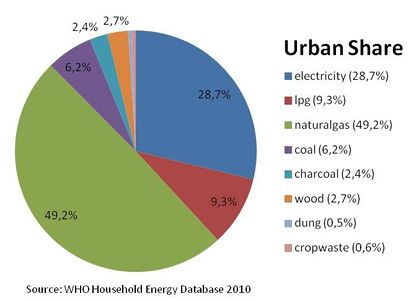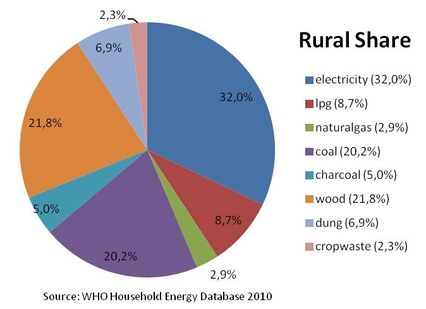Knowledge fuels change
For over a decade, Energypedia has shared free, reliable energy expertise with the world.
We’re now facing a serious funding gap.
Help keep this platform alive — your donation, big or small, truly matters!
Thank you for your support
Difference between revisions of "Kyrgyzstan Energy Situation"
***** (***** | *****) |
***** (***** | *****) |
||
| Line 119: | Line 119: | ||
Kyrgyzstan's population is 5.57 million. The population density is 27 people per square kilometer. Urban population compromises 35% while the rural population makes up 65%. The literacy rate (age 15+) is 98.7% | Kyrgyzstan's population is 5.57 million. The population density is 27 people per square kilometer. Urban population compromises 35% while the rural population makes up 65%. The literacy rate (age 15+) is 98.7% | ||
| − | The GDP | + | The GDP in 2010 was 4.6 billion US$ and the GDP per capital was US$ 860. GDP grew more than 6% in 2007-08, but declined after that. |
| − | |||
| − | GDP grew more than 6% in 2007-08, but declined after that. | ||
National income sources share consist of 48% agriculture, 12.5% industry, and 39.5% services. | National income sources share consist of 48% agriculture, 12.5% industry, and 39.5% services. | ||
| − | | + | |
= National Energy Situation = | = National Energy Situation = | ||
Revision as of 13:45, 20 December 2011
| Kyrgyzstan | |||
| |
| ||
|
Capital |
Astana | ||
|
Official language(s) |
Kazak, Russian | ||
|
Government |
| ||
|
President |
| ||
|
Prime Minister |
| ||
|
Total area |
2,725,000 km sq | ||
|
Population |
5.57 million | ||
|
Population density (per sq. km) |
27 | ||
|
GDP (nominal) |
| ||
|
GDP Per capita |
| ||
|
Currency |
| ||
|
Time zone |
| ||
|
Calling code |
| ||
Geography and Climatic Conditions[1]
Kyrgyzstan is a landlocked country located in the heart of Central Asia. It is bordered by Kazakhstan, Tajikistan, Uzbekistan, and China.
The Tien Shan mountain range cover roughly 95% of the country. It has a polar climate in the Tien Shan Mountains, a subtropical climate in the Southwest, and temperate climatic conditions in the Northern foothills. Shrub land, savannah, and grassland make up 56% of the land and cropland compromises 27%.
The average low temperature is 4.8°C while the average high temperature is 17.0°C.[2]
In contrast to neighboring countries, Kyrgyzstan has small amounts of fossil fuels, but enjoys large amounts of water resources with an abundant hydro power potential.
The land area covered by forest is 4.5% but is decreasing.
Socio-economic Development[3]
Kyrgyzstan's population is 5.57 million. The population density is 27 people per square kilometer. Urban population compromises 35% while the rural population makes up 65%. The literacy rate (age 15+) is 98.7%
The GDP in 2010 was 4.6 billion US$ and the GDP per capital was US$ 860. GDP grew more than 6% in 2007-08, but declined after that.
National income sources share consist of 48% agriculture, 12.5% industry, and 39.5% services.
National Energy Situation
Kyrgyzstan has an abundant supply of hydro power. It also has locally exploitable coal, oil, and natural gas.
It was the first country in the Commonwealth of Independent States(CIS) to develop an independent regulatory agency for economic regulation of the energy sector.
Primary energy shares in 2008 comprised of the following : Hydro 31.8%, coal 18.5%, gas 21.5%, oil 28.1%, renewable and waste 0.1%. [4]
Approximately 95% of the population is connected to the grid. Losses in the distribution system range from 40-50% and reliabality is poor. Electricity losses are greater in residential areas. About 30% of the distribution systems need to be replaced.
The bulk (90%) of Kyrgyzstan's generating capacity is hydro power. The country has for some time now considered the development of hydro power resources as the central foundation of its overall economic development.
Potential for Renewable Energies
Low tariffs and abundant hydroelectric power resources have limted the development of RE sources. Hydro-power is the only documented renewable energy source for electricity production on national level[4]
There are,however, some potentials for solar energy and large scale and micro-hydro power plants. There are about 2,600 hours of sunshine per year. A law on renewable energy was adopted in 2008. It includes biomass small scale projects, small hydropower programs, solar small scale projects and wind energy in the national program.As of now, biogas plants have only been established by private initiatives.
Household Energy Situation
Share of Fuel Types
Percentage of energy types used for cooking in urban areas
Percentage of energy types used for cooking in rural areas
Policy framework
Market Risks
Relevant Institutions and organisations
Existing projects
External links
References
- ↑ GIZ (2009): Regional Reports on Renewable Energies Energies - 30 Country Analysis on Potentials and markets
- ↑ http://data.un.org/CountryProfile.aspx?crName=
- ↑ https://www.cia.gov/library/publications/the-world-factbook/geos/kg.html
- ↑ 4.0 4.1 http://www.iea.org/stats





















